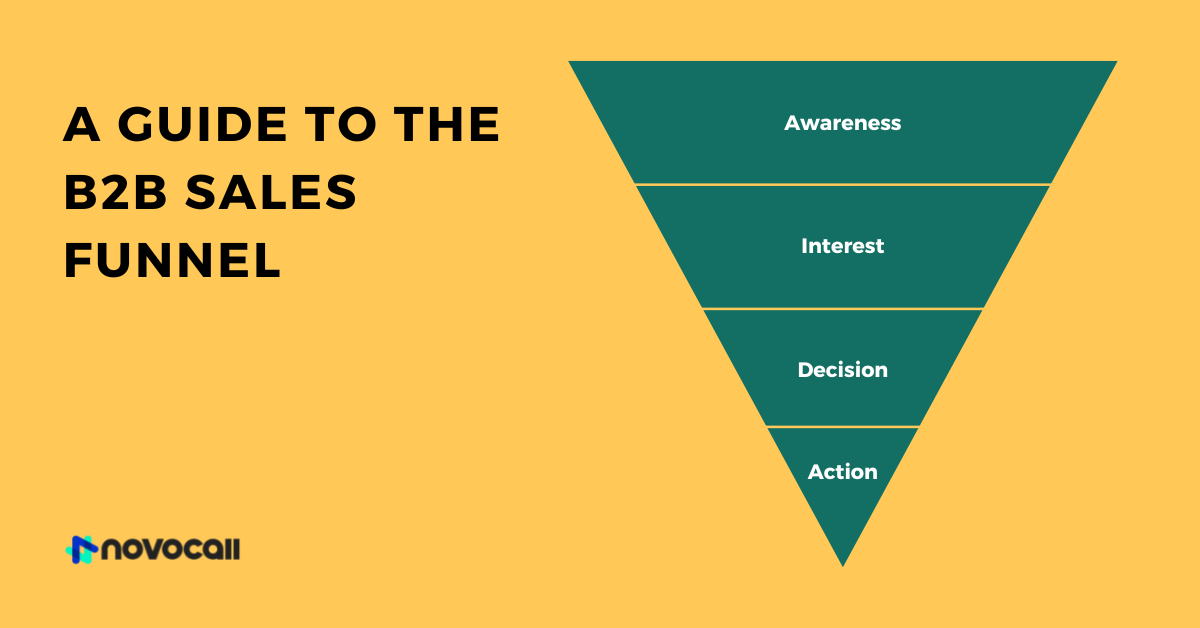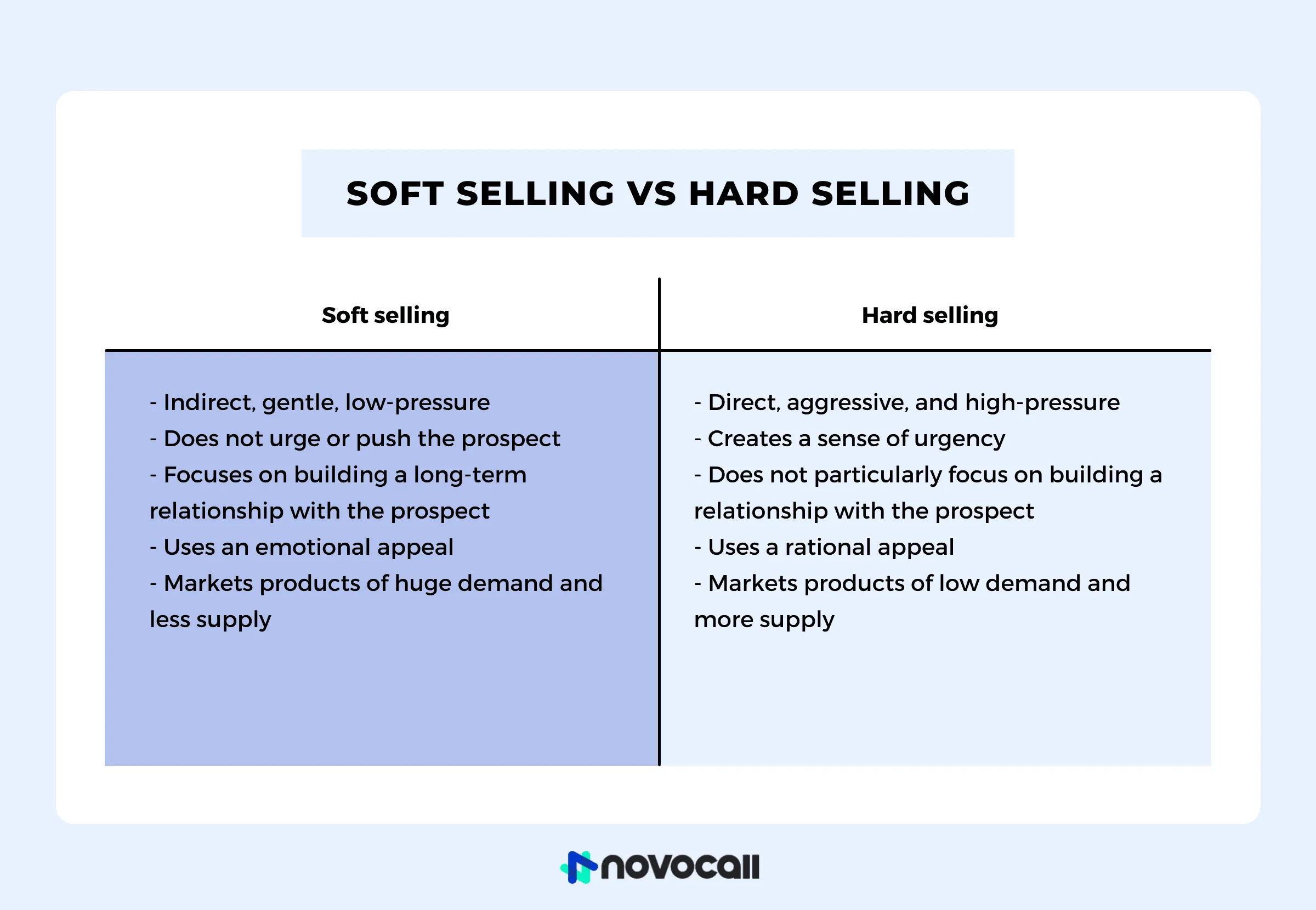


Start driving better conversations.
Novocall will be your new favorite business phone system.

Ever heard of the phrase ‘customers don’t want to be sold’?
That’s because they’re bombarded with salespeople aggressively trying to sell to them all the time, whether it be through cold calls or door to door. That’s why customers don’t like to be sold — rather, they want you to help them providing value and a solution to their problems.
That’s why soft selling is widely practiced by many sales professionals to build a relationship with their prospects before even thinking about selling.
But what exactly is soft selling and how can you use this approach to generate more leads?
Soft selling eliminates the strategy of being pushy and aggressively chasing a prospect via emails or phone calls every day.
Salespeople who use soft selling techniques don’t pitch products right away. Instead, they focus on subtle persuasion and non-aggressive tonality when speaking with a prospect. The aim here is to create a comfortable and low-pressure sales environment for the prospect.
This is so that when the sales rep eventually pitches their product or service, the buying decision comes naturally.
While it might seem like it, soft selling is not passive selling. Sales reps who practice this approach don’t just sit around waiting for sales to pour in — they still put themselves out there and take the initiative to reach out to prospects first.
The difference comes in the way you approach the selling.
Here’s a summary of the differences:

In a nutshell, soft selling is focused on building relationships with a prospect and is an indirect approach to selling products. Unlike with hard selling, it doesn’t force urgency upon the prospect and rushes them to sign contracts.
Now that you already understand what soft selling is, let’s look at 5 soft selling strategies to help you learn or build a high-performing team of effective sales agents.
This is the most crucial part of sales outreach — spend time researching about your prospects and qualifying them before making the first contact. This allows you to find out if your prospects fit your ideal customer profile and whether your product or service will be a good fit for them.
Ultimately, the aim of doing thorough research is so that you can better understand why they’ll need your product or service and tailor a pitch suited to their needs.
Consider finding out the following information about your client:
When you eventually get on a call with your prospect, find out more about your prospect that you couldn’t find online. You should be asking these questions to find out about your prospects’ motivations:
Avoid sounding too formal when having a call with a prospect or writing an email. You know how those typical sales conversations go — they’re boring and make you seem robotic.
If you need to polish your outreach email writing and write emails that convert into sales, consider enrolling in a web copywriting course.
The thing is when people feel they are no longer in a formal environment, they feel less constrained to share their thoughts and enjoy a conversation — they won’t feel they are being sold. It’s much easier to sell to a friend rather than a person you barely know.
Pushy sales agents always try to sell straight away. That’s why it’s so difficult to understand if you have chosen the right vendor and if their products are good.
Before selling anything, try to provide some value without any strings attached. It’s like offering a ‘free sample’, just to gain that certainty of the right choice.
After your discovery call, you should be familiar with the biggest challenges your prospect faces and will be able to offer some free content or helpful links that would be of interest to your prospect. Researching and creating such content shouldn’t take too much time for you and your team.
When working on understanding your ideal personal profile, you will quickly realize that most problems of customers repeat. Identify three to five key challenges and create targeted content for each segment in the form of an online brochure, an online podcast, an ungated ebook, or a video presentation.
Talking too much about your company and what services you offer is like shooting yourself in the foot.
Doing so blocks you from understanding your customer goals, pain points, decision-makers profiles, and budgets — the information you will need to make an informed decision about the next steps in the sales process and create a good offer.
The focus is on your customer, so let them talk instead of selling right away. Use this opportunity to learn more about their goals and challenges and then come up with a killer offer that lives up to your prospect’s expectations.
By actively listening to your prospect, you build credibility and trust, while letting your prospects feel heard and appreciated.
When testing this strategy, remember to apply active listening and show your engagement in a conversation. Don’t ask questions and be silent for the rest of a conversation, but engage by paraphrasing, summarizing, clarifying, and reflecting on what your prospect says.
Once you have communicated your offer, don’t push a decision too hard on your prospect. Remember, you don’t want to put any pressure on them, but you also don’t want them to forget about your offer.
There’s a fine line between following up excessively and following up too little, making it hard to pinpoint when exactly you should give them a nudge.
To work out your perfect follow-up timing, ask prospects how much time it may take them to make a decision. Once this time has passed, consider sending a follow-up email to remind them about your common arrangement. You can also make a follow-up call.
In the meantime, you can still continue sending some useful materials to educate future customers on their challenges and inspire action.
No one likes that old type of sales approach where a decision is being forced on you. By soft selling, you will be able to establish a genuine bond and credibility with your prospects, so they would drop their shield of mistrust and finally buy from you.
Applying soft selling strategies is a process, not a magic tool. To make it work, you have to apply these strategies every day and polish your skills over time. It’s time to start now!

Margo is a freelance growth marketing strategist. She creates content that converts website visitors into paying customers for SaaS companies by building sales funnels.
Related articles
Subscribe to our blog
Get insights & actionable advice read by thousands of professionals every week.

